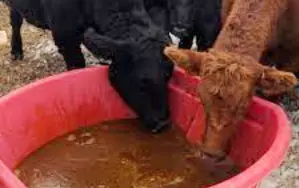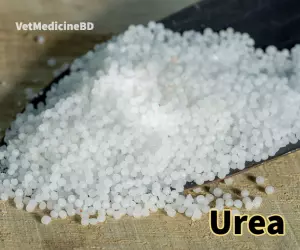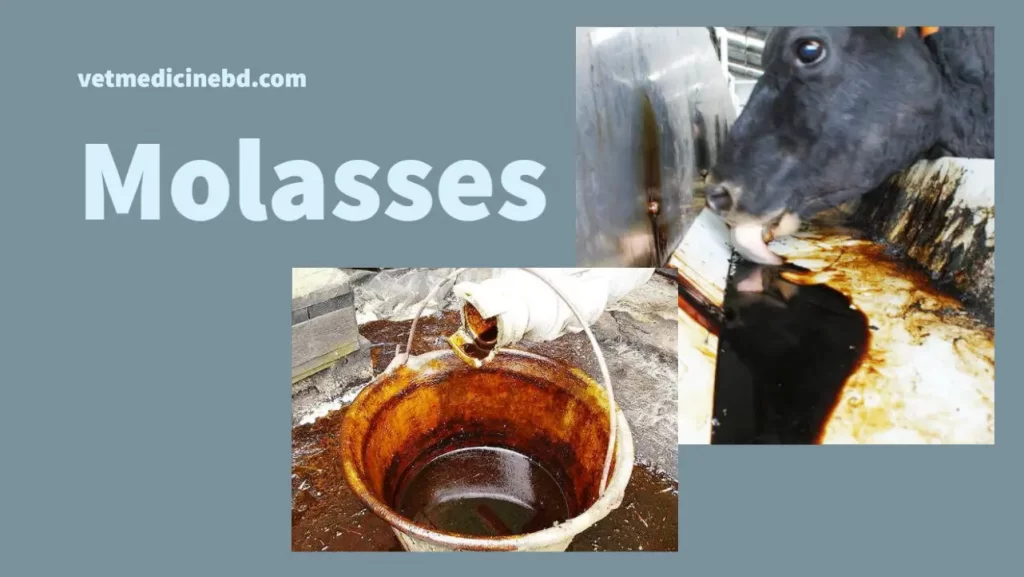Molasses for cattle feed is the best nutrition for large animals. molasses is a by-product of sugar mills. It is a versatile nutritious and delicious liquid feed that provides many essential nutrients through animal feed. Although people have been using molasses as animal feed since ancient times, its multifaceted use is being observed at the present time.
Molasses for cattle feed is one of the feed ingredients used as a source of energy and as a binder in compound or ready feeds. When dried hay is treated or processed with urea and molasses, its nutritional value is greatly increased.
Table of Contents
Molasses for cattle feed
Although molasses is basically a carbohydrate or starchy food, it has many versatile nutrients. As a result molasses have much more practical field. Below is a brief nutritional analysis.

Nutritional value of molasses
Dry Matter – 81%
Energy / Calories – 9.8 Mg / kg
Protein – 5.5%
Fat – 1.0%
Fiber -0.1%
Ash-14.8%
Calcium – 9.2 g / kg
Phosphorus – 0.6 g / kg
Potassium – 51.0 g / kg
Magnesium – 4.0 g / kg
Manganese – 64.0 g / kg
Zinc – 18 g / kg
Iron – 183 g / kg
Use of molasses for cattle feed
Molasses is directly edible to cattle feed, it has many uses. The most notable use of molasses is in making urea molasses straw (UMS). At present, the Livestock Department of the Government of India and some non-governmental organizations are training and encouraging farmers to make UMS.
Molasses is widely used in feed mixing. Molasses is also used to make raw grass or straw silage for cattle.
Benefits of using molasses in cattle feed
- The nutritional value of chitagur is much higher than other ingredients. Increases animal fat or increases productivity by providing plenty of energy.
- Fills the body with all the necessary nutrients including calcium, phosphorus and iron.
- Increases the taste, aroma and nutritional value of food.
- Increases appetite and digestion.
- Improves the digestive system.
- Cows increase the production of cow’s milk.
- Goats and sheep gain body weight rapidly.
- Buffaloes, goats, etc. increase the working power of active animals.
- The lean animal provides fast energy to the body.
- Essential ingredients for making granular, UMS, UMMB, silage etc.
- Use in pond water increases water quality and production capacity of natural food.
- Reduces farm food costs.
General rules for feeding molasses to cattle
Large animals (cows, buffaloes, horses) – 100-200 gm / with every meal / daily.
Small animals (goats, sheep 0- 50-100 gm / with every meal / daily.
Following the advice of a registered veterinarian or nutritionist.
If the animal is not keen on eating molasses, make it a habit to eat a very small amount every day as it will quickly become his favorite food. De-worm the animal properly and apply anthelmintic every 3-6 months.
Urea for cattle feed
Urea is a type of chemical fertilizer. The amount of protein in our country’s animal feed, especially straw, is very low, but protein has an important role in rapid growth. The hay that we feed the animals contains a very small amount of protein. Urea contains 245% crude protein.

The amount of hay protein can be greatly increased by mixing it with high-strength protein at a low cost. This type of urea processed hay makes the body grow faster and increases the meat production in the animal.
Safe method of urea feeding
The following three simple and safe methods of urea feeding are in vogue all over the world.
Urea molasses straw (ums)
Urea Molasses Multi Nutrient / Mineral Block (ummb)
Directly with feed
Why urea is the food of cattle?
Yes, dear farmer, this question may come to everyone’s mind. Why urea is the food of cattle? Can urea be given to humans and other animals? Urea can only be used for chewing animals. It is also a deadly poison to all animals and birds.
The stomach and digestion process of cows or goats is completely different from the stomachs of other animals including humans. The stomachs of chewing animals are four-limbed.
Cattle get nitrogen from their dietary protein which is absorbed by the animal through conversion to ammonia compounds. But if too much nitrogen is consumed or too much ammonia gas is produced, it produces severe toxicity in the cow and if the dose is too high, the cow may die.
Read more: Corn for animal feed and nutrition


Thanks for information
It is good explanation. Could you send the side effect of this feed.
Great goods from you, man. I’ve understand your stuff previous to and you’re just extremely magnificent. I actually like what you’ve acquired here, really like what you’re stating and the way in which you say it. You make it enjoyable and you still take care of to keep it wise. I can not wait to read much more from you. This is really a great website.
I discovered your blog site on google and check a few of your early posts. Continue to keep up the very good operate. I just additional up your RSS feed to my MSN News Reader. Seeking forward to reading more from you later on!…